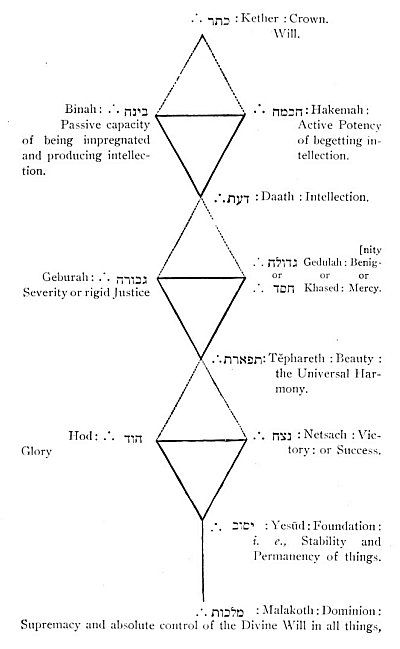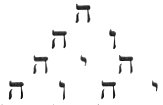He was the same with the dismembered Zagreus, the son of Persephoné, an Ancient Subterranean Dionusos, the horned progeny of Zeus in the Constellation of the Serpent, entrusted by his father with the thunderbolt, and encircled with the protecting dance of Curetes. Through the envious artifices of Here, the Titans eluded the vigilance of his guardians and tore him to pieces; but Pallas restored the still palpitating heart to his father, who commanded Apollo to bury the dismembered remains upon Parnassus.
Dionusos, as well as Apollo, was leader of the Muses; the tomb of one accompanied the worship of the other; they were the same, yet different, contrasted, yet only as filling separate parts in the same drama; and the mystic and heroic personifications, the God of Nature and of Art, seem, at some remote period, to have proceeded from a common source. Their separation was one of form
p. 586
rather than of substance: and from the time when Hercules obtained initiation from Triptolemus, or Pythagoras received Orphic tenets, the two conceptions were tending to re-combine. It was said that Dionusos or Poseidon had preceded Apollo in the Oracular office; and Dionusos continued to be esteemed in Greek Theology as Healer and Saviour, Author of Life and Immortality. The dispersed Pythagoreans, “Sons of Apollo,” immediately betook themselves to the Orphic Service of Dionusos, and there are indications that there was always something Dionysiac in the worship of Apollo.
Dionusos is the Sun, that liberator of the elements; and his spiritual meditation was suggested by the same imagery which made the Zodiac the supposed path of the Spirits in their descent and their return. His second birth, as offspring of the highest, is a type of the spiritual regeneration of man. He, as well as Apollo, was preceptor of the Muses and source of inspiration. His rule prescribed no unnatural mortification: its yoke was easy, and its mirthful choruses, combining the gay with the severe, did but commemorate that golden age when earth enjoyed eternal spring, and when fountains of honey, milk, and wine burst forth out of its bosom at the touch of the thyrsus. He is the “Liberator.” Like Osiris, he frees the soul, and guides it in its migrations beyond the grave, preserving it from the risk of again falling under the slavery of matter or of some inferior animal form. All soul is part of the Universal Soul, whose totality is Dionusos; and he leads back the vagrant spirit to its home, and accompanies it through the purifying processes, both real and symbolical, of its earthly transit. He died and descended to the Shades; and his suffering was the great secret of the Mysteries, as death is the grand mystery of existence. He is the immortal suitor of Psyche (the Soul), the Divine influence which physically called the world into being, and which, awakening the soul from its Stygian trance, restores it from earth to Heaven.
Of HERMES, the Mercury of the Greeks, the Thoth of the Egyptians, and the Taaut of the Phœnicians, we have heretofore spoken sufficiently at length. He was the inventor of letters and of Oratory, the winged messenger of the Gods, bearing the Caduceus wreathed with serpents; and in our Council he is represented by the ORATOR.
The Hindu_s called the Sun SURYA; the Persians, MITHRAS;
p. 587
the Egyptians, OSIRIS; the Assyrians and Chaldæans, BEL; the Scythians and Etruscans and the ancient Pelasgi, ARKALEUS or HERCULES; the Phœnicians, ADONAI or ADON; and the Scandinavians, ODIN.
From the name SURYA, given by the Hindu_s to the Sun, the Sect who paid him particular adoration were called Souras. Their painters describe his car as drawn by seven green horses. In the Temple of Visweswara, at Benares, there is an ancient piece of sculpture, well executed in stone, representing him sitting in a car drawn by a horse with twelve heads. His charioteer, by whom he is preceded, is ARUN [from ו ?A?W?R, AUR the Crepusculum?], or the Dawn; and among his many titles are twelve that denote his distinct powers in each of the twelve months. Those powers are called Adityas, each of whom has a particular name. Surya is supposed frequently to have descended upon earth, in a human shape, and to have left a race on earth, equally renowned in Indian story with the Heliades of Greece. He is often styled King of the Stars and Planets, and thus reminds us of the Adon-Tsbauth (Lord of the Starry Hosts) of the Hebrew writings.

Moe is the founder of GnosticWarrior.com. He is a father, husband, author, martial arts black belt, and an expert in Gnosticism, the occult, and esotericism.





